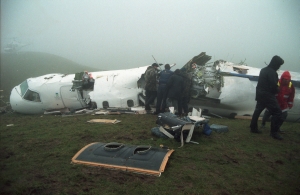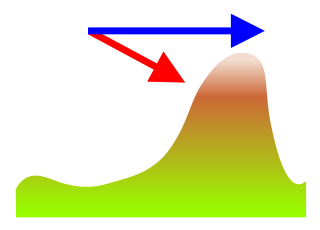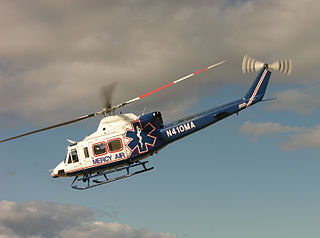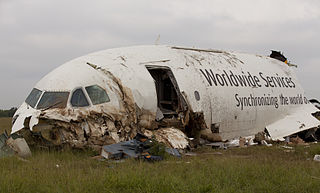
Avionics are the electronic systems used on aircraft. Avionic systems include communications, navigation, the display and management of multiple systems, and the hundreds of systems that are fitted to aircraft to perform individual functions. These can be as simple as a searchlight for a police helicopter or as complicated as the tactical system for an airborne early warning platform.

American Airlines Flight 965 was a regularly scheduled flight from Miami International Airport in Miami, Florida, to Alfonso Bonilla Aragón International Airport in Cali, Colombia. On December 20, 1995, the Boeing 757-200 flying this route crashed into a mountain in Buga, Colombia, around 9:40 pm killing 151 of the 155 passengers and all eight crew members.
In aviation, a controlled flight into terrain is an accident in which an airworthy aircraft, fully under pilot control, is unintentionally flown into the ground, a mountain, a body of water or an obstacle. In a typical CFIT scenario, the crew is unaware of the impending collision until impact, or it is too late to avert. The term was coined by engineers at Boeing in the late 1970s.

Aviation safety is the study and practice of managing risks in aviation. This includes preventing aviation accidents and incidents through research, educating air travel personnel, passengers and the general public, as well as the design of aircraft and aviation infrastructure. The aviation industry is subject to significant regulation and oversight.

A traffic alert and collision avoidance system, is an aircraft collision avoidance system designed to reduce the incidence of mid-air collision (MAC) between aircraft. It monitors the airspace around an aircraft for other aircraft equipped with a corresponding active transponder, independent of air traffic control, and warns pilots of the presence of other transponder-equipped aircraft which may present a threat of MAC. It is a type of airborne collision avoidance system mandated by the International Civil Aviation Organization to be fitted to all aircraft with a maximum take-off mass (MTOM) of over 5,700 kg (12,600 lb) or authorized to carry more than 19 passengers. CFR 14, Ch I, part 135 requires that TCAS I be installed for aircraft with 10-30 passengers and TCAS II for aircraft with more than 30 passengers. ACAS/TCAS is based on secondary surveillance radar (SSR) transponder signals, but operates independently of ground-based equipment to provide advice to the pilot on potentially conflicting aircraft.

Crossair Flight 3597 was a scheduled flight from Berlin Tegel Airport, Germany, to Zürich Airport, Switzerland. On 24 November 2001, the Crossair Avro RJ100 operating the route, registered as HB-IXM, crashed into a wooded range of hills near Bassersdorf and caught fire. Out of the 33 occupants, nine made it out alive.

An airborne collision avoidance system operates independently of ground-based equipment and air traffic control in warning pilots of the presence of other aircraft that may present a threat of collision. If the risk of collision is imminent, the system recommends a maneuver that will reduce the risk of collision. ACAS standards and recommended practices are mainly defined in annex 10, volume IV, of the Convention on International Civil Aviation. Much of the technology being applied to both military and general aviation today has been undergoing development by NASA and other partners since the 1980s.

Ansett New Zealand Flight 703 was a scheduled flight from Auckland to Palmerston North. On 9 June 1995, the de Havilland Canada Dash 8-100 aircraft crashed into the Tararua Range on approach to Palmerston North. The flight attendant and three passengers died as a result of the crash; the two pilots and 15 passengers survived.

A synthetic vision system (SVS) is a computer-mediated reality system for aerial vehicles, that uses 3D to provide pilots with clear and intuitive means of understanding their flying environment.

In aviation, a terrain awareness and warning system (TAWS) is generally an on-board system aimed at preventing unintentional impacts with the ground, termed "controlled flight into terrain" accidents, or CFIT. The specific systems currently in use are the ground proximity warning system (GPWS) and the enhanced ground proximity warning system (EGPWS). The U.S. Federal Aviation Administration (FAA) introduced the generic term TAWS to encompass all terrain-avoidance systems that meet the relevant FAA standards, which include GPWS, EGPWS and any future system that might replace them.
The Capstone Program was a United States government-funded aviation safety program for the state of Alaska, primarily focusing on rural areas of the state. This joint effort – between the Federal Aviation Administration (FAA), the Alaska Pilot's Association, commercial operators, the University of Alaska, MITRE Corporation, some avionics manufacturers and individual pilots – cut the accident rate in the eastern part of Alaska by around 40%.

The safety of emergency medical services flights has become a topic of public interest in the United States, with the expansion of emergency medical services aviation operations, such as air ambulance and MEDEVAC, and the increasing frequency of related accidents.
The Runway Awareness and Advisory System (RAAS) is an electronic detection system that notifies aircraft flight crews on the ground of their position relative to their allocated runway. It is a type of Runway Situation Awareness Tool (RSAT).

Turkish Airlines Flight 634 was a scheduled domestic passenger flight from Turkish Airlines' hub at Istanbul Atatürk Airport to Diyarbakır Airport in southeastern Turkey. On 8 January 2003 at 20:19 EET, the aircraft operating the flight, a British Aerospace Avro RJ100, struck the ground on final approach approximately 900 metres (3,000 ft) short of the runway threshold during inclement weather conditions. In the following collision with a slope, a post-crash fire broke out, killing 75 of the 80 occupants, including the entire crew. This is the deadliest aviation accident to involve the BAe 146.

Charles Donald Bateman, often known as Don Bateman, was a Canadian electrical engineer and the inventor of the Ground Proximity Warning System (GPWS), a device that is responsible for a marked decline in controlled flight into terrain accidents, such as the Mount Erebus Disaster with Air New Zealand Flight 901.
"It's accepted within the industry that Don Bateman has probably saved more lives than any single person in the history of aviation."

PauknAir Flight 4101 was a British Aerospace 146 that crashed on a flight from Málaga, Spain, to the Spanish North African exclave of Melilla on 25 September 1998. All 38 passengers and crew on board the aircraft were killed in the accident.

First Air Flight 6560 was a domestic charter flight that crashed on landing at Resolute, Nunavut, Canada, on 20 August 2011. Of the 15 people on board, 12 were killed and the remaining three were severely injured. The Boeing 737-200 of First Air was operating a service from Yellowknife, Northwest Territories, when it struck a hill in cloud near Resolute Bay Airport.

UPS Airlines Flight 1354 (5X1354/UPS1354) was a scheduled cargo flight from Louisville, Kentucky, to Birmingham, Alabama. On August 14, 2013, the Airbus A300 flying the route crashed and burst into flames short of the runway on approach to Birmingham–Shuttlesworth International Airport. Both pilots were pronounced dead at the scene of the crash. They were the only people aboard the aircraft. It was the second fatal air crash for UPS Airlines.

The 2009 Aviastar British Aerospace 146 crash occurred on April 9, 2009, when a British Aerospace 146 crashed into Pikei Hill during a ferry flight from Sentani Airport to Wamena Airport, both in Indonesia's Papua province. Due to the force of the impact the aircraft was destroyed and all 6 crew members were killed. The aircraft was carrying voting paper to Wamena as well as several other goods, as a parliamentary election was held in the month. The wreckage was found in Pikei Hill, Tengah Mountain, Tangma, Yahukimo District.

Tara Air Flight 197 was a scheduled domestic flight operated by Tara Air for parent company Yeti Airlines from Pokhara Airport to Jomsom Airport in Nepal. On 29 May 2022, the Twin Otter aircraft carrying 22 people departed at 09:55 NPT and lost contact with air traffic controllers about 12 minutes later at 10:07 (04:22). The wreckage was located 20 hours later on a mountainside. All 22 passengers and crew were killed, and all 22 bodies were recovered. This was Tara Air's second deadly accident on this route, after Flight 193 in 2016.


















